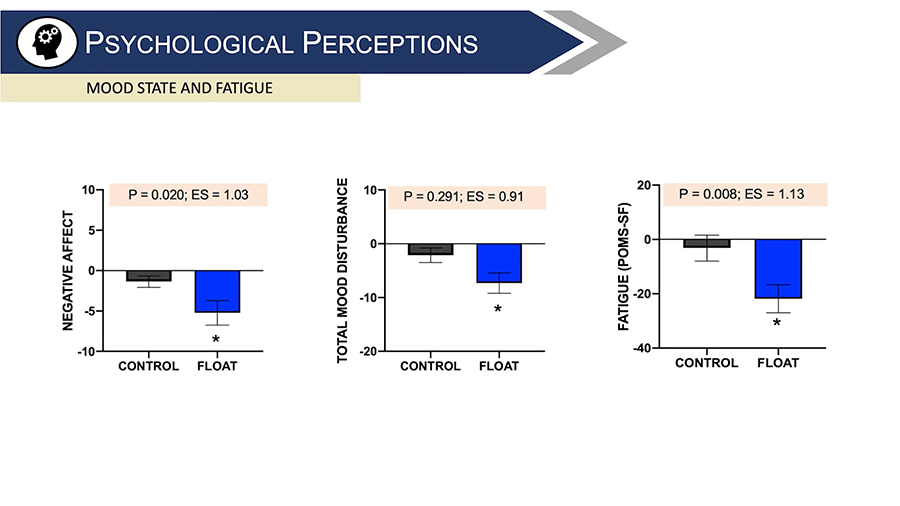Buoyant Benefits - Mental and Physical Recovery in Athletics
When we think of sports athletes, we often think of their success in terms of physical ability, performance under pressure, and in-game strategy. However, much of the brilliance and outstanding success we see from top athletes is built on the less flashy foundation of practice, conditioning, diet, and recovery. Based on our article from last month about Dr. Matt Driller’s work around floating and sports, we’d like to look at some other research being done by Dr. Lydia Caldwell out of Ohio State University (now at the University of North Texas).
Float tanks have become increasingly popular in recent years, with professional athletes and weekend warriors using them as a tool for mental and physical recovery. Dr. Caldwell has worked with float tanks for years and presented at the 2017 and 2021 Float conferences. She has worked with special forces military and top-performing athletes to increase their performance and has incorporated float tanks into her research and protocols for both.
At the 2017 Float Conference, Dr. Caldwell presented her own introduction to float tanks and their contributions to performance through increased recovery, decreased fatigue, and improvements in mood. At that time, she was beginning to work with the University of Ohio, and in 2021, she returned to the conference stage to present the findings from the float tanks they installed there.
In her first study at the University of Ohio, Dr. Caldwell brought in 14 trained individuals who had never floated. Each person floated for a 60-minute floatation session and had their mood and stress hormone levels assessed before and after the session. The results were overwhelmingly positive – floatation significantly reduced levels of the stress hormones cortisol, epinephrine, and norepinephrine. Participants also reported improvements in mood, including decreased tension and negative emotions.
This means that both from their own perspective and on a base physiological level, these athletes were experiencing less stress after their float sessions. This stress reduction was both physical and mental and came with many other side benefits and seemingly no adverse effects (or contraindications).
Dr. Caldwell’s findings also highlighted the importance of acclimating to the experience and not giving up after one session. Many participants took 10-15 minutes to truly relax and benefit from the experience, going through an initial period of discomfort and apprehension before becoming more familiar with the float tank environment.
In her second study, Dr. Caldwell looked specifically at recovery after an intense resistance training workout. She brought in 12 experienced weightlifters to test how floating affected their ability to recover from a grueling lower-body workout. This time, she gave all participants 2 float sessions before the study so that they were all familiar with the experience and wouldn’t experience any anxiety from entering a strange new environment.
The participants did an intensive squat session designed to induce soreness and muscle damage and then either floated or watched calming nature videos in a recliner for 60 minutes. This program was extensive, and they brought the athletes back into the lab to run more tests after 24 and 48 hours. They even went as far as controlling food intake before the study and having each participant complete both recovery conditions.
The results were notable and helped to define more clearly the things that floatation therapy helps out with in terms of physical strain and recovery:
The float group reported significantly less muscle soreness at 1, 24, and 48 hours after exercise compared to the control.
Floating also improved mood, fatigue, and pain sensations during the 48-hour recovery period.
However, floating did not affect metabolic recovery – both groups recovered blood lactate levels within the hour.
There was also no difference in muscle damage markers like creatine kinase levels or changes in muscle performance between the float and control groups.
While floating didn’t speed up actual muscle repair, it did make the participants feel subjectively better as they recovered from their strenuous workout. This is likely due to the profound relaxation and pain relief induced by the floatation experience.
As a result of these studies, Dr. Caldwell theorizes that float tanks may be best used as a chronic recovery tool throughout a training season rather than just acutely before competitions. As with so many of these pioneering studies, more research is still needed to clarify the ideal timing and frequency of floating for exercise recovery.
Dr. Caldwell points out that taking care of mental health is just as important as physical recovery in sports performance. If float tanks help athletes feel rejuvenated and better able to cope with their rigorous training demands, that benefit alone makes them a worthwhile recovery modality.
And that goes for everyone, not just the professional athletes among us. Although performance is the goal, it’s all of the invisible work done on the sidelines that allows for brilliant highlight reels and competitive wins. Float tanks aren’t just a tool for physical recovery; they are a practice that helps us to maintain good moods, cultivate a more resilient attitude, and ultimately be more likely to achieve the goals that we’ve set for ourselves.




